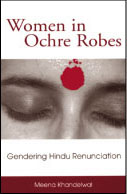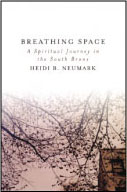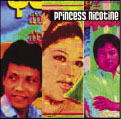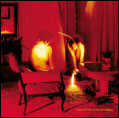Women in Ochre Robes:
Gendering Hindu
Renunciation
Meena Khandelwal
SUNY Press 2004
 Women
in Ochre Robes, an ethnography of sanyasinis in Haridwar, north
India, gives us a glimpse into the lives of women who have renounced
their ordinary lives in order to pursue spiritual liberation full-time.
Author and anthropologist Meena Khandelwal undertook the research
as part of her doctoral thesis, but the book is not overly academic
or dry to read. What makes Women in Ochre Robes so interesting
is that Khandelwal includes her personal reflections as she studies
the sanyasinis.
Women
in Ochre Robes, an ethnography of sanyasinis in Haridwar, north
India, gives us a glimpse into the lives of women who have renounced
their ordinary lives in order to pursue spiritual liberation full-time.
Author and anthropologist Meena Khandelwal undertook the research
as part of her doctoral thesis, but the book is not overly academic
or dry to read. What makes Women in Ochre Robes so interesting
is that Khandelwal includes her personal reflections as she studies
the sanyasinis.
In a society where the ordinary goals for
women are marriage, children, family, prosperity and sensual pleasure,
there is a lot of tension between worldly responsibilities and otherworldly
pursuits. Sanyasinis are always striking a balance between spiritual
life and pragmatic goals, between being women and transcending gender.
For example, Khandelwal explains how female renunciates often discourage
other women from taking sanyas. “While they themselves may
be exceptions, it is important for ordinary people to first experience
marriage and family life before they can succeed on the difficult
path of celibacy and detachment. To take sanyas without being fully
prepared or “ripe? can be downright dangerous.”
Khandelwal focuses on two sanyasinis, both
of whom have determined their lives in fairly radical ways. Anand
Mata left her husband and a successful career as a school principal
to follow the path of meditative solitude, choosing to live alone
in a small, quiet ashram. Before meeting her, Khandelwal expected
“a fiercely independent, rigidly disciplined woman with fearsome
and dramatic matted locks living as a recluse on the fringes of
society,? but what she found was a short, ordinary-looking
woman with a sweet face. Closeness develops between the two and
the interviews turn into personal talks for Khandelwal?s own
growth. Anand Mata tells her, “This is not for your thesis,
but so you will understand.” After a few visits, Anand Mata
invites Khandelwal to stay with her in her rooms so she can understand
more about sanyasinis by living with them. As Khandelwal serves
and cleans, she sees how Anand Mata follows the path of devotion,
accepting all who come to her with love.
The second woman Khandelwal focuses on is
Baiji, a guru with two busy ashrams who had to resist her family?s
wishes to marry in order to pursue her spiritual interests. “Soft-spoken
and quick to smile,? Baiji also has to be strict as she organizes
all the details of the ashrams? activities, as well as looking
after her devotees. Khandelwal was transformed from guest to integrated
member of the community when she volunteered to work at the ashram.
Her first task was sewing burlap bags into mattresses. Everyone
works in the ashram, especially Baiji. As one of her devotees observes,
“Other mahatmas will have their disciples worship and serve
them, but Baiji serves her disciples and does more work than anyone
at the ashram.” Once when she was very tired, Baiji said to
Khandelwal:?You must write in your thesis that sanyasins also
get sleepy.”
Women in Ochre Robes shows how, in
sanyas, a woman?s strength is her moral, spiritual and maternal
nature. My own spiritual teacher always told me, “Be a mother
to all.” The women interviewed in the book give nourishment
in many forms — advice, especially for women who feel safer
with a female guru, physical and spiritual food (prasad), even scolding
as an act of motherly love. There is also a consensus that women
are flexible — they have less ego or pride to deal with than
men. Anand Mata explains: “Women are icons of surrender. It
is easy for them to bow down to a younger man; but a young male
will be reluctant to bow down even to an elderly sanyasini because
his ego will come in the way. Eventually men will have to surrender
like women do.”
In reading this book, I was reminded that
the tensions of the worldly and otherworldly are present wherever
you go and whatever spiritual commitment you make. Also, the intention
and the goal are one and the same. I recommend this book to anyone
interested in finding out more about sanyas — it is full of
helpful stories, information and advice. — Swami Radhananda
back to top
A Woman’s Path:
Women’s Best Spiritual Travel Writing
Lucy McCauley, Amy G. Carlson & Jennifer Leo, eds.
Travelers’ Tales 2003
 A
Woman?s Path is a gem of a little book. Before reading it,
I had experienced many times the transformative potential of travel.
However, I had never registered the act of travel as a potential
catalyst for spiritual growth. As editor Lucy McCauley suggests,
“In the act of moving from one place to another, somehow a
space is created where, if we?re lucky, a moment of clarity
alights on us and offers a window into our natures and the nature
of everything around us."
A
Woman?s Path is a gem of a little book. Before reading it,
I had experienced many times the transformative potential of travel.
However, I had never registered the act of travel as a potential
catalyst for spiritual growth. As editor Lucy McCauley suggests,
“In the act of moving from one place to another, somehow a
space is created where, if we?re lucky, a moment of clarity
alights on us and offers a window into our natures and the nature
of everything around us."
The book is filled with short, personal tales
that capture these precious “moments of clarity.” The
stories themselves range from small, even habitual trips to life-changing
odysseys. Anne Lamott shares a “miracle moment? on a
turbulent plane ride home from St. Louis where she is trapped between
a stern Latvian woman and a seemingly fanatical right-wing Christian,
both of whom by the end of the flight become her “cousins.”
Abigail Seymour tells us about a young, newly divorced woman who
has run away from her life in New York to the unknown in Spain where
she walks on the pilgrimage of Camino de Santiago not once but twice,
undergoing an awesome self-realization. Maya Angelou describes her
magical sojourn in Ghana, where her terror at crossing a shabby
bridge connects her to the spirits of the past.
These stories are beautifully diverse and
yet unified by the common thread of some kind of awakening. This
is the ideal collection of little narrative jewels (the longest
story is eleven pages) to accompany you on your own journey. The
magical ingredients of hope, faith, trust, compassion and that special
alchemy of Light woven into this collection of spiritual travel
writing might form the talisman that could transform your dreary
daily commute on the train into an opportunity for inspiration and
connection. It did mine. — Sikeena Karmali
back to top
Breathing Space:
A Spiritual Journey in the South Bronx
Heidi B. Neumark
Beacon Press 2003
 Heidi Neumark?s Breathing Space thrums with energy. I came to the
book seeking inspiration about what it means to live an active,
engaged spiritual life, and that?s just what it gave me.
Heidi Neumark?s Breathing Space thrums with energy. I came to the
book seeking inspiration about what it means to live an active,
engaged spiritual life, and that?s just what it gave me.
The book is a memoir of Neumark?s nineteen
years as pastor of Transfiguration Lutheran Church in one of New
York City?s poorest neighbourhoods. As she began describing
life in the South Bronx, I felt like I was entering another world.
It’s a place where city officials spare no expense building
a state-of-the-art juvenile prison, but consistently underfund the
high school just one block away. A place where, due to the environment
of urban poverty, more children die of asthma than almost anywhere
else in the U.S. A place where Neumark?s prayers are often
interrupted by gunshots, where death is an almost daily occurrence.
I wondered how people survive in those circumstances, not just physically,
but how they keep hope alive.
Neumark sees the church as a sanctuary, where
residents can find space to breathe in the midst of their difficulties.
She also sees it as a centre of action, where people can come together
to revitalize their lives and the whole neighbourhood. During the
1980s and “90s, residents of the South Bronx created a veritable
social movement, taking matters into their own hands where politicians
seemed to turn a blind eye. Neumark and a coalition of other churches
and one mosque supported community members as they started new schools,
built low-cost housing, ran programs to prevent AIDS and domestic
violence, and took on many smaller projects.
While community activism forms the background
to the book, Neumark?s focus is the intimate, daily stories
of the people in her congregation. Visitors from a suburban Lutheran
church once remarked at how “political? Neumark?s
sermons were, but she and her congregation didn‘t see it that
way. The personal stories demonstrate just how intertwined social
activism and spiritual life can be. The quest for self-determination,
justice and peace have both an inner and an outer dimension.
Neumark reflects frankly about wealthy or
middle-class churches using the poor “as a backdrop for our
miraculous charity.” She doesn‘t have clear intellectual
answers about how to be a white spiritual leader in a neighbourhood
of mostly black and Hispanic families. But she engages in the journey
as best as she can, raising her kids in the South Bronx, questioning
herself, listening to others, being practical, and most importantly
connecting with others through the heart. She concludes: “I
have learned from my sisters and brothers how to keep on when it
seems impossible. Their refrains have reframed my view of life:
“God will make a way out of no way? and “Se hace
camino al andar? (You make the way by walking).”
Neumark?s writing style is in keeping
with her ideal of “breathing space,? combining lightness
with depth. There is a lovely momentum to her words. I felt swept
along as I read, inhaling the spirit and feeling of the stories
so that by the end I was energized. Neumark passes on her passion
for life, for God, for practising seeing the Divine spark in each
person. — Juniper Glass
back to top
Princess Nicotine:
Folk and Pop Sounds of Myanmar
Folk and Pop Sounds of Sumatra, vol. 1
Sublime Frequencies 2004
 Sublime
Frequencies, a new label run and curated by Alan Bishop of the Sun
City Girls, is cause for celebration among "world" music
heads. Devoted to Bishop's own vision of "world,"
"ethnic" and "fusion" music, the first CDs
in the series actually do what most recordings of non-Western music
try for and rarely achieve: they document living, breathing art
created within the context of its own everyday culture. The usual
tropes of "folk," "pop" or "classical"
music are blurred, ignored or put where they rightfully belong:
within the time and place where the music was experienced, created
and recorded.
Sublime
Frequencies, a new label run and curated by Alan Bishop of the Sun
City Girls, is cause for celebration among "world" music
heads. Devoted to Bishop's own vision of "world,"
"ethnic" and "fusion" music, the first CDs
in the series actually do what most recordings of non-Western music
try for and rarely achieve: they document living, breathing art
created within the context of its own everyday culture. The usual
tropes of "folk," "pop" or "classical"
music are blurred, ignored or put where they rightfully belong:
within the time and place where the music was experienced, created
and recorded.
Sun City Girls, the group Bishop formed with
his brother Richard in the early 1980s, remains one of the most
original, deep and freaky enigmas that has ever emerged out of the
American underground. Over the course of hundreds of recordings,
they have documented a truly ritualistic blend of psychedelic rock
that has encompassed everything from free improv covers of pop and
jazz standards, to an uncanny ability to play any form of "ethnic"
music they take a stab at.
So far the CDs in this new series seem to
fall into one of two types: collages (Radio Java, Radio Palestine,
Radio Maroc and I Remember Syria) and musical anthology (Princess
Nicotine: Folk and Pop Sounds of Myanmar, Folk and Pop Sounds of
Sumatra, vol. 1), with the sole exception being an album of fairly
straight-up field recordings (Night Recordings from Bali).
![]() One
of the immediately striking things about these recordings is the
lack of "serious analysis" involved. The usual framing
through the lens of ethnomusicology is pretty well absent. The sparse
liner notes, mostly written by Bishop, are personal, impressionistic
and rarely deal with the technical aspects of the music. None of
these CDs come with a 64-page booklet of modes, maps or italicized
instruments. In fact, by regular world music standards, all of them
are poorly recorded, the bulk being transfers from beaten-up cassette
tape or 45s.
One
of the immediately striking things about these recordings is the
lack of "serious analysis" involved. The usual framing
through the lens of ethnomusicology is pretty well absent. The sparse
liner notes, mostly written by Bishop, are personal, impressionistic
and rarely deal with the technical aspects of the music. None of
these CDs come with a 64-page booklet of modes, maps or italicized
instruments. In fact, by regular world music standards, all of them
are poorly recorded, the bulk being transfers from beaten-up cassette
tape or 45s.
The remarkable and refreshing thing about
this approach is that, while Bishop's stamp is everywhere
(they all sort of look and sound like Sun City Girls albums), the
power and presence of a real and beautiful otherness shines through.
Instead of the supposed "purity" and "authenticity"
of most "traditional" and "timeless" world
music, you get the living breathing fire of people dreaming and
creating out of the glory, horror and complexity in which they exist.
The two music anthology CDs are mind-blowing,
jaw-dropping revelations. Each one documents the folk and pop sounds
of a specific region (Myanmar and Sumatra) and features indescribable
fusions of indigenous music and Western pop, rock, funk and jazz.
Fusion is a word and genre that should make
most people (myself included) run for the hills. It is usually a
kind of mainstream, codified version of how Western music is fused
with a sanitized version of non-Western music, and is more about
maintaining a musical status quo than any real exploration of identity
or difference. In a sense, you end up getting the worst of both
worlds.
Not so with these two CDs. The levels of innovation, intensity,
musical complexity and ease with which it is all executed make most
Western attempts at fusion seem (at best) laughable or (at worst)
like some form of well-intentioned hucksterism.
This is fusion as a form of magic and ritual.
It opens up a space where something "other" actually
happens and all timid preconceptions about style and authenticity
are mutated or simply done away with. It is this otherness that
revitalizes that tired genre and also goes way beyond it.
And so, Sublime Frequencies is now (right
now!) realizing some of the most incredible music ever committed
to tape, aural documents that actually reveal something about the
foreign cultures in which they were recorded.
What else would you possibly ask for from
"world music," from music? Highly, highly recommended
stuff. - Sam Shalabi
back to top
The Lost
Teachings of Yoga:
Yoga’s Ancient Philosophy Revealed
Georg Feuerstein
Sounds True 2003
| click here to listen |  |
 Georg
Feuerstein?s new audio compilation of yogic teachings begs
for a road trip.
Georg
Feuerstein?s new audio compilation of yogic teachings begs
for a road trip.
In the six-CD set The Lost Teachings of Yoga,
Feuerstein takes the listener on an illuminating trip to the little-known
origins of yoga 5000 years ago in the Indus-Saraswati civilization.
Yoga likely began with stone-age shamans and was later practised
during the Neolithic era in northern India, confirmed by archeologists
who have recently found items such as clay tablets depicting yogic
postures.
As a leading yoga scholar and historian,
Feuerstein fears that neglect and disinterest are threatening the
loss of treasured yogic teachings contained in the Vedas, Yoga Sutras
of Patanjali and other ancient texts. He proffers an invitation
to look beyond the current popularity of physical yoga to many other
forms of this ancient science, such as Raja, Karma and Bhakti yogas.
He states that yoga is the art and science of disciplining the body-mind.
Its practice is a great experiment not to be undertaken by the faint
of heart.
In addition to historical information on
the origins of asanas, chanting, mantra, meditation and other practices,
Feuerstein encapsulates major moral principles of yoga such as nonharming,
truthfulness and nonstealing.
“The Seven Stages of Psychospiritual
Growth? stands out as an excellent discussion of the role
of self-acceptance and self-understanding as precursors to self-discipline
and further spiritual growth, defined as self-transcendence and
self-transformation.
The tone of The Lost Teachings of Yoga is
reminiscent of a university lecture — a relief from some of
the motivational CDs on the market. On a personal note, Feuerstein
asserts, “Spirituality is always radical.” He offers
insights into his own yogic practices and reveals his cynicism about
topics such as the sorry state of truthfulness in our modern society.
Feuerstein successfully collapses 5000 years
of yoga into seven hours — perfect to listen to during a long
road trip. This compilation is comprehensive and thorough. It will
be helpful for seasoned yogis or anyone who asks the questions:
What is yoga? Where did it come from? Who am I? What is my purpose?
The Lost Teachings of Yoga begs for an open
road, wide vistas and a curious mind wishing to undertake the greatest
experiment of all — a mindful, nonharming life. — Hardeep Dhaliwal
back to top
Cicadidae
Kammerflimmer Kollektief
Staubgold 2003
| click here to listen |  |
 I
first heard this album when I was living in Barcelona. My time in
Spain was not the holiday fun that you or I might imagine. I was
broke, sad, and working for a few bucks an hour at a restaurant
full of crazy people. My musical creativity had come to a grinding
halt with no money to fix broken equipment and no time to make music
after the long hours at work. Luckily, my roommate ran a record
label so my apartment was piled high with new and interesting music.
Kammerflimmer Kollektief?s album Cicadidae bubbled to the
surface in the sea of CDs and somehow captured the harsh beauty
that my life was at that point.
I
first heard this album when I was living in Barcelona. My time in
Spain was not the holiday fun that you or I might imagine. I was
broke, sad, and working for a few bucks an hour at a restaurant
full of crazy people. My musical creativity had come to a grinding
halt with no money to fix broken equipment and no time to make music
after the long hours at work. Luckily, my roommate ran a record
label so my apartment was piled high with new and interesting music.
Kammerflimmer Kollektief?s album Cicadidae bubbled to the
surface in the sea of CDs and somehow captured the harsh beauty
that my life was at that point.
Shimmering and elusive, each track is a brilliantly
orchestrated little story of brass, strings and percussion with
grinding, crackly, computer-programmed noise and beats all melded
together to form a seamless organic entity. Electronic elements
woven together with instrumental improvisation, or is it the other
way around? It’s the kind of music that makes my heart feel
tangy — beauty and longing captured in pristine simplicity,
yet it has the noise and imperfections of the real world. Meditative
music for our harsh world. A soundtrack of inspiration for a society
gone mad.
No matter how crazy life seemed to get, I
could listen to this album and things somehow seemed, I don‘t
know, not better, but it was okay that things weren‘t okay.
Like the natural ebb and flow of confusion and inspiration made
sense.
Based in southern Germany, the six-person
Kollektief describes itself as “a collective expression by
musicians communicating with each other in the spaces between control
and loss of control, intuition and reflection, density and transparency.”
Cicadidae is their third release on the brilliant Berlin-based label
Staubgold (www.staubgold.de).
Now that I am back in Canada with a life that
is a little more stable, I listen to this very same album and it
is different. I hear new stories, sounds I didn‘t hear before.
Is it possible to be objective? Is it possible to separate our senses
from the mental / emotional / spiritual space that we are in? Is
this a music review, or my personal experience of someone else?s
personal expression? — Andrew Wedman
back to top